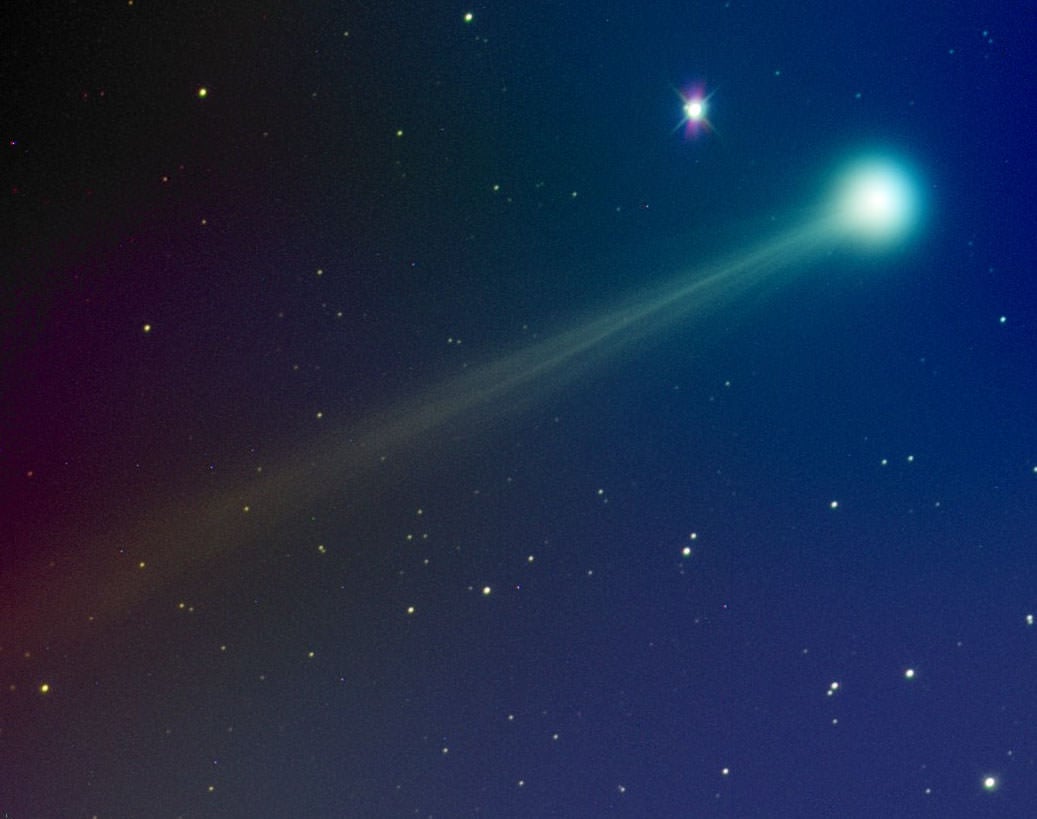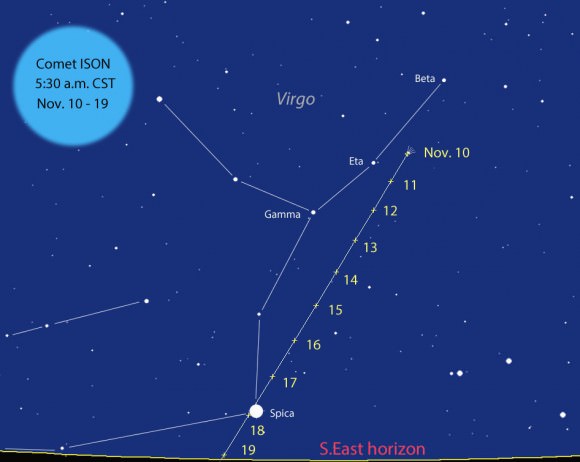After a sleepy week, Comet ISON is suddenly coming alive. Several amateur astronomers and at least one professional astronomers are reporting today that the comet has brightened at least a full magnitude overnight. Two days ago it glowed at around magnitude 7.5 and was visible weakly in 10x50 binoculars from a dark sky. Now it's surged to around magnitude 5.5 - just above the naked eye limit - and continues to brighten. Several amateur astronomers have even seen it without optical aid.
[caption id="attachment_106414" align="aligncenter" width="580"]
Comet ISON on Nov. 10 before the recent outburst with well-developed dust (upper) and gas tails. Click ot enlarge. Credit: Damian Peach[/caption]
ISON's appearance has radically changed too. A week ago the comet developed a second gas or ion tail streaming alongside the wider, brighter dust tail. That new appendage has since grown like Pinocchio's nose to nearly equal the length of the dust tail. I spotted it with averted vision Tuesday morning Nov. 12 through a 15-inch (37 cm) telescope. More exciting, the ISON's head has been much brighter and more compact. Astronomers rate a comet's
degree of condensation
or "DC" on a scale of 0 to 9 from extremely diffuse with no brightening in the center to disk-like or stellar. In recent days, Comet ISON has been packing it in at DC=6 or moderately compact and bright. Now amateurs are reporting that the comet's head has brightened and become much more compact with a DC of 8.
[caption id="attachment_106415" align="aligncenter" width="580"]
Comet ISON in outburst with a completely changed tail appearance and bright, very compact coma shot this morning. Gonzalez reports the comet at magnitude 6.4. Click to enlarge. Credit: Juanjo Gonzalez[/caption]
[caption id="attachment_106419" align="aligncenter" width="580"]
You can watch Comet ISON evolve right before your eyes in this panel of photos taken by Juanjo Gonzalez. Top row left-right: Nov. 3 and Nov. 9. Bottom row left right: Nov. 12 and Nov. 14. The tail structure changes are dramatic. Click to enlarge. Credit: Juanjo Gonzalez[/caption]
Backing up reports of the outburst, astronomer Emmanuel Jehin of the
TRAPPIST
(TRAnsiting Planets and PlanetesImals Small Telescope) team, noted a tenfold increase in dust production around the comet's nucleus on Nov. 11 and 12 plus additional jets of material blasting into the coma. Jehin reports that the inner coma near the nucleus is still very sharp and shows no sign of disruption - so far, ISON's hanging in there.
[caption id="attachment_106417" align="aligncenter" width="580"]
If you haven't seen the comet yet, you can use this map to track it through the weekend as it zips quickly through Virgo. The map shows the sky facing southeast just before the start of morning twilight or about 100 minutes before sunrise. ISON should be plainly visible in binoculars in a dark sky. Created with Chris Marriott's SkyMap program[/caption]
This is all great news for comet observers. The intense heat of the sun is beginning to boil away the comet's ice with greater fury. The heat may also be exposing new cracks or breaks in ISON's crust. Fresh ice means even more material becomes available for the sun to vaporize and likely additional jumps in brightness in the next day or two.
[caption id="attachment_106425" align="aligncenter" width="580"]
Trouble finding Virgo? Use this wide-view map to get oriented. Slide from Mars toward Spica near the southeastern horizon. ISON is about halfway between Spica and Gamma Virginis. The map shows the sky around 5-5:30 a.m. CST. Stellarium[/caption]
 Universe Today
Universe Today


